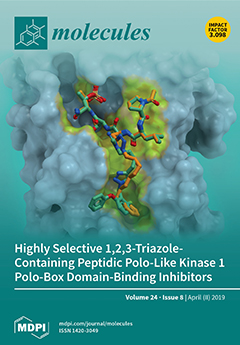The chemical composition and biological activity of essential oils isolated from the leaves of
Siparuna aspera,
Siparuna macrotepala,
Piper leticianum,
Piper augustum and the rhizome of
Hedychium coronarium were evaluated. These species are used medicinally in different ways by the Amazonian communities that live near the Kutukú mountain range. Chemical studies revealed that the main components for the two
Siparuna species were germacrene D, bicyclogermacrene, α-pinene, δ-cadinene, δ-elemene, α-copaene and β-caryophyllene; for the two
Piper species β-caryophyllene, germacrene D, α-(
E,E)-farnesene, β-elemene, bicyclogermacrene, δ-cadinene and for
H. coronarium 1,8-cineole, β-pinene, α-pinene and α-terpineol. The antioxidant activity of all essential oils was evaluated by 1,1-diphenyl-2-picrylhydrazyl (DPPH), 2,2′-azino-bis(3-ethylbenzothiazoline-6-sulfonic acid) diammonium salt (ABTS), photochemiluminescence (PCL) quantitative assays, and DPPH and ABTS bioautographic profiles, with different results for each of them. Antimicrobial activity studies were carried out on three yeasts, six Gram positive and four Gram negative bacteria, by means of the disc diffusion method. The essential oil of
H. coronarium showed the most relevant results on
L. grayi,
K. oxytoca and
S. mutans,
P. augustum and
P. leticianum on
S. mutans. An antibacterial bioautographic test for
H. coronarium was also carried out and highlighted the potential activity of terpinen-4-ol and 1,8-cineole.
Full article






